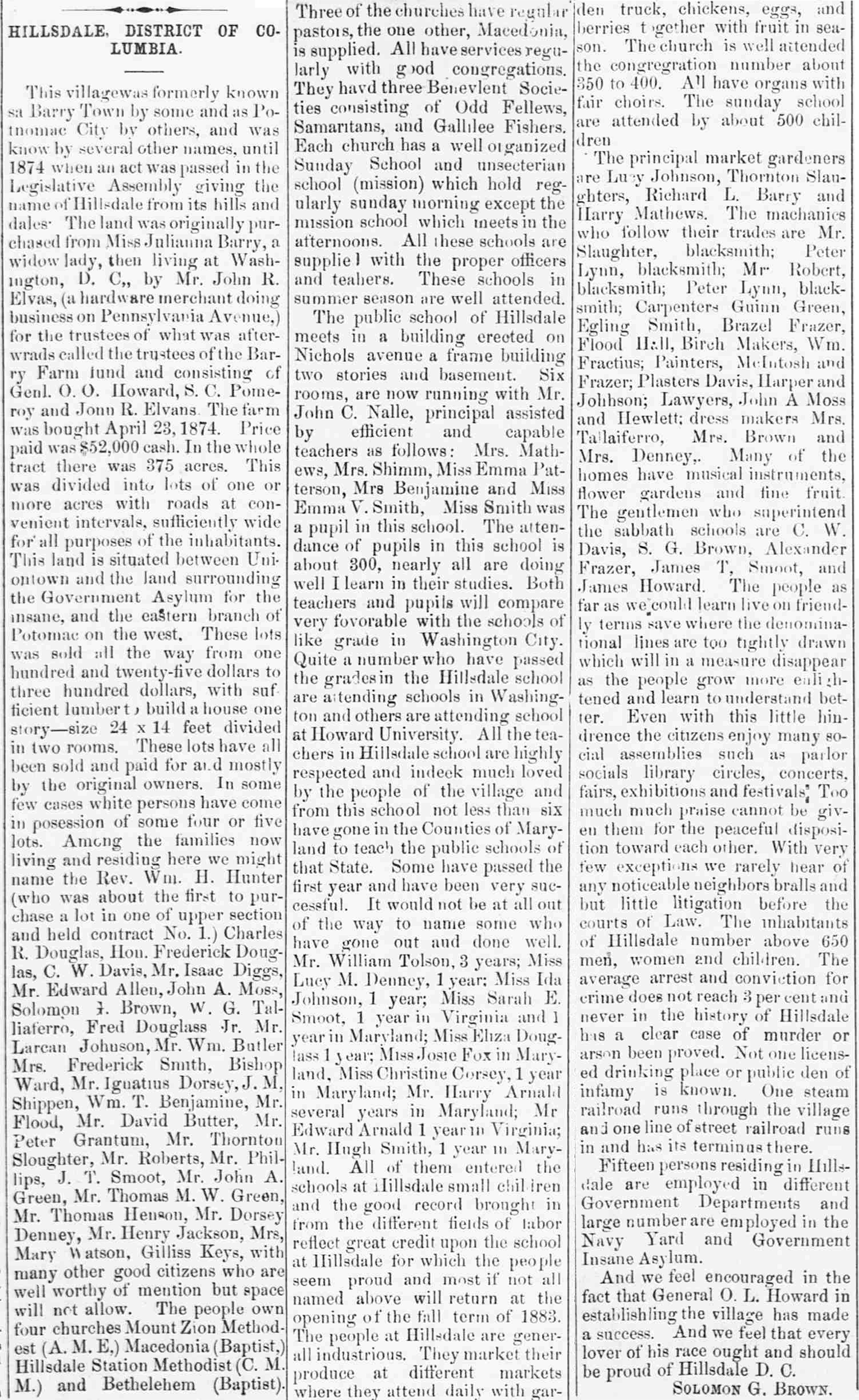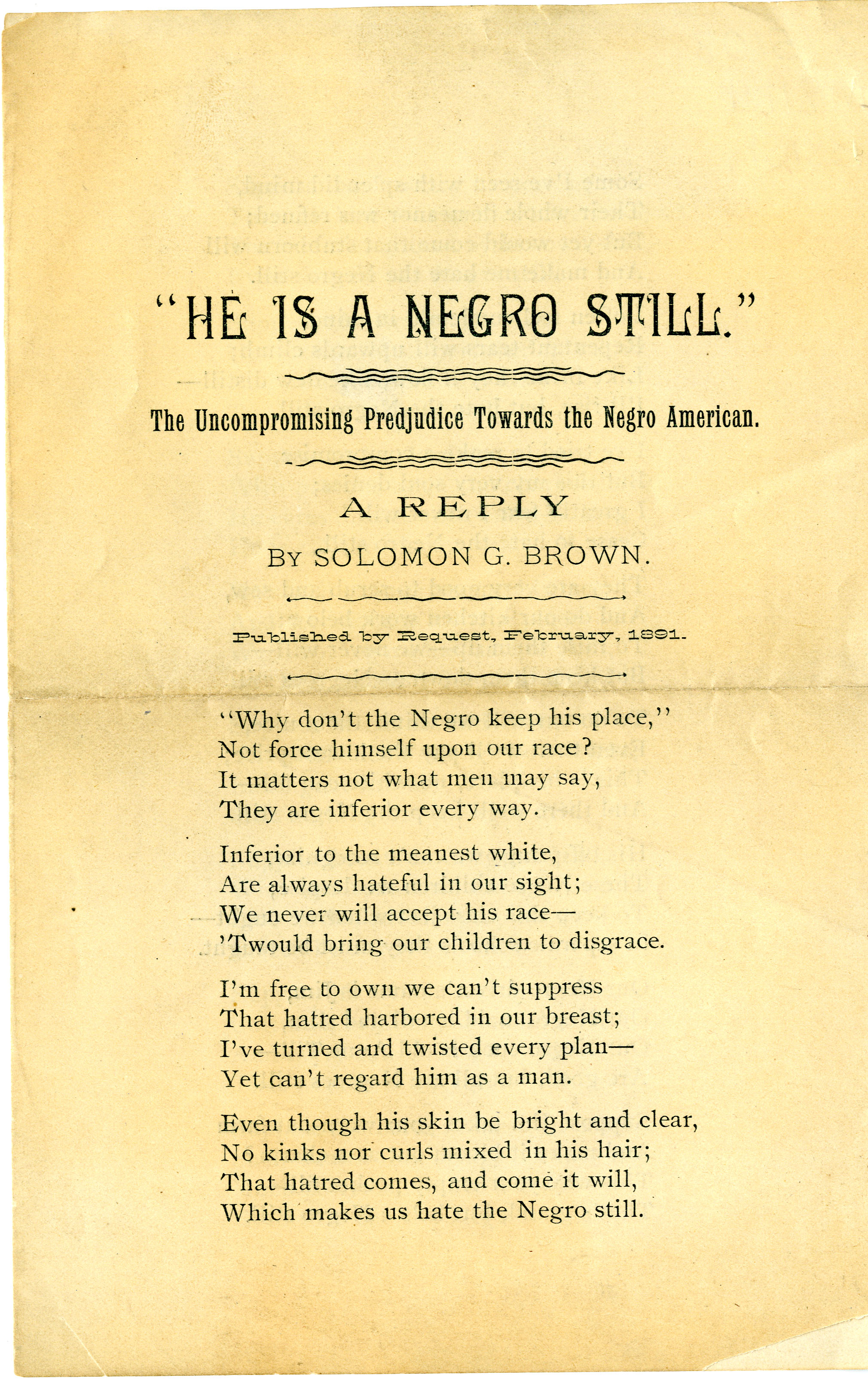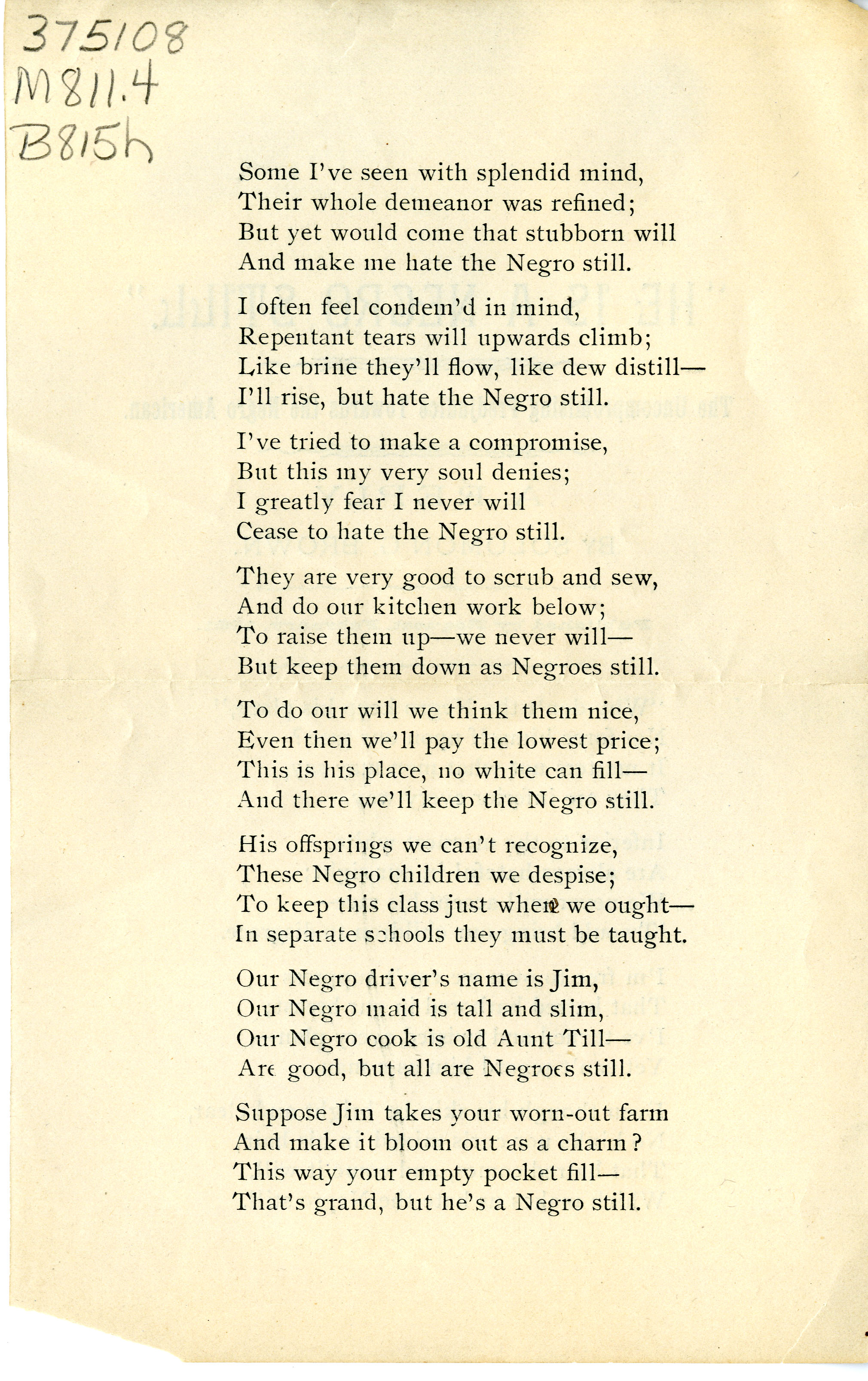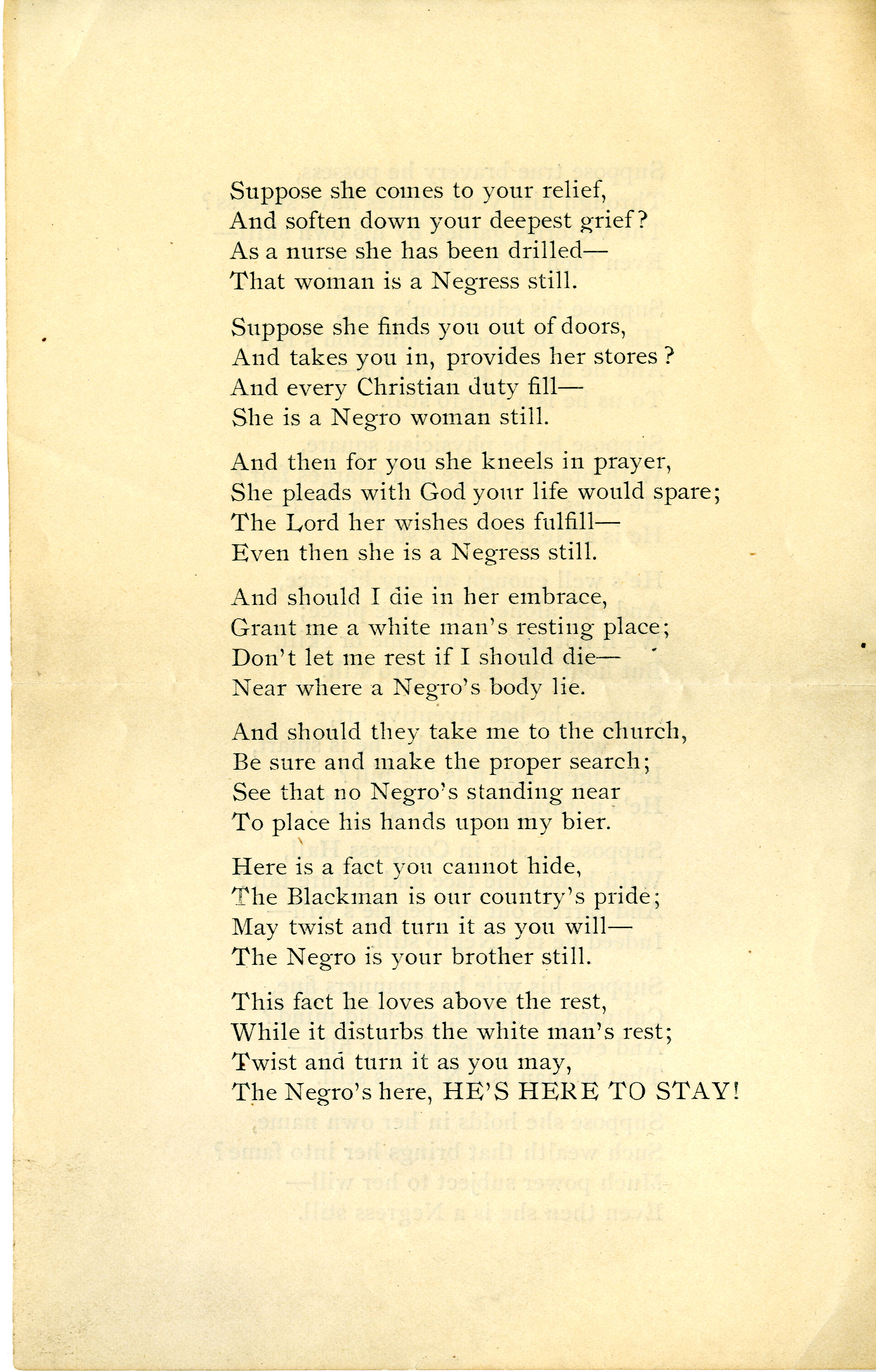Solomon Brown
Born in 1829 to free black parents along the border between Maryland and the District of Columbia, Solomon Galleon Brown would become, at age 23, the first black employee of the Smithsonian. Starting out as a laborer in the Exchange Office, he ultimately became the personal assistant of Spencer Baird, the second secretary of the Smithsonian. By the time of his 1904 retirement, Brown was renowned within DC’s African American community as a self-educated scientist and naturalist, a popular educator, an illustrator and mapmaker, a poet, and political leader.
Early Years

When Brown’s father died in 1833, he and his five siblings were left destitute. Unable to care for all of her children, young Solomon’s mother apprenticed him to Lambert Tree, a clerk in the DC City Post Office.2 It was in the Tree household that Solomon first learned to make the strategic friendships with influential white patrons that would allow him to both survive and thrive as a free black man in the hostile environment of antebellum DC. When Brown was 15 years old, he convinced Tree to secure for him a position as a laborer in the city post office, where he was to assist Joseph Henry, Samuel Morse, and Alfred Vail in constructing the nation’s first telegraph line between DC and Baltimore. Eight years later in 1852, after Henry became the first secretary of the Smithsonian, he hired Brown as a general laborer.3
An Inhospitable Environment
Though willing to hire Brown, his new employer had a low opinion about the intellectual limitations of African Americans. Like many nineteenth century scientists, Henry believed that the process of evolution had left African Americans a “child race,” and not fit for intellectual work.4 Additionally, although Henry did not support slavery, he believed that African Americans were incompatible with American democracy and advocated their removal from the country.5 In 1862, even as Congress was moving to abolish slavery in Washington, DC, Henry banned abolitionist speakers from appearing at the Smithsonian.6 The institution’s Board of Regents was also hostile to the existence of assertive, intelligent and free black men and women. Henry’s longtime friend, Jefferson Davis, was both a member of the Board of Regents and the future president of the Confederacy.7Also a regent was Chief Justice Roger Taney, the jurist who penned the infamous Dred Scott decision that declared all persons of African descent “so ... inferior that they had no rights which the white man was bound to respect; and that the negro might justly and lawfully be reduced to slavery for his benefit.”8
Strategic Alliances
Given this inhospitable environment, it’s all the more remarkable that Solomon Brown was able to achieve so much at the Smithsonian. By 1862, Brown could describe his responsibilities as encompassing “almost every branch of work that is usual and unusual about the S.I.”9 A talented artist, he was tasked with drawing maps and illustrating scientific lectures.10 By 1870, he was supervising the work of other men, both black and white, and had begun to collect artifacts and specimens for the institution’s collections, effectively serving as a curator.
In order to navigate these treacherous waters, Brown cultivated a friendship with Spencer Baird, the Assistant Secretary of the Smithsonian, just as he had done earlier with Lambert Tree at the DC Post Office. Beginning in 1855, Brown and Baird began a lifelong correspondence during the summers in which Baird and his family left for points north to escape both the stifling heat of DC and the recurrent threat of yellow fever.11 These letters offer a fascinating insight into the relationship between these two men. Not only did Brown keep Baird informed of the goings on at the Smithsonian, he also looked after Baird’s household when he was away, which included repairing and cleaning his friend’s house as needed.12
Though this friendship was certainly not equal, Brown and Baird enjoyed a very close relationship. The intensity of the feelings the two men shared are evident in a letter written in the summer of 1855, in which Brown expressed how much he missed his friend who was away: “I have lost [my] dear play mate .... it appears solemn to go into your room and see no one occupying your desk.”13
Brown and Baird however were more than close friends; they were patron and protege. As Assistant Secretary, Baird received no support for collecting from Joseph Henry. The Secretary was opposed to the very idea of a museum, which he feared would take resources away his preference for establishing a world class scientific research center. Cut off from access to the Smithson bequest, Baird was compelled to build the museum through gifts and donations alone.14 In his struggle to build the National Museum (and become its first director), Baird recruited Brown as a key ally.
Brown’s informative summer missives weren’t just friendly; they were meant to inform the Assistant Secretary if Henry was planning on taking action against the museum so that Baird could respond appropriately. Even more significantly, Brown was there to receive the artifacts and specimens that arrived at the museum during the summer. Without Brown’s attention, it is probable that Henry would have refused delivery. The importance of Brown’s presence at the Smithsonian is underlined by Henry’s attempt to discard the specimens in the “Fish Room.” As Brown related in letter dated 22 Sept 1856, “Prof Henry awoke ... in a Bad Humor and found that he had a Headach[e] ... and attributed the whole to the Fish Room.” He then “formed a determination to rid the Building of the specimens .... and before they could get fairly to work Dr. G[irard] arrived and I shortly after him and after some talk his Excitement abated.”15 As a result of Brown’s and Girard’s intervention, these early specimens from the Smithsonian’s ichthyology collection were saved.
In return for Brown’s efforts in protecting the museum, Baird protected his protege from Henry’s mercurial moods. In one August 1857 letter, Brown wrote that “Prof. Henry kicked up a great dust before he left town but it had no effect on me for I was working by your orders and I believe that I was right.” A second letter written later that month informed Baird that “Our situation here has been everything but agreeable since your much regretted absence – But however we have got along so far without any Broken Bones and do live in hope of a better future.”16
Baird was an important patron when Brown pressed his employer for a pay raise in 1864. In a letter to Baird dated 6 August 1864, he expressed his desire to leave the Smithsonian, explaining that “Prof Henry dont seem willing to allow his men more wages and I for one can not at the present rates of living remain for the same money.”17 Not only had wartime inflation increased the cost of living in DC, Solomon Brown had just married his sweetheart Lucinda, and his paycheck now needed to sustain a household.18 It’s likely that Baird intervened on his behalf, since Brown stayed at the Smithsonian for the next four decades. Additionally, on at least two occasions, Baird helped Brown pay his debts with additional gifts of money.19
A Leader of the Black Community
Solomon Brown became a trusted leader among the laborers, messengers, drivers, watchmen and janitors who comprised the bulk of the Smithsonian’s black workforce. By 1866, he was supervising the work of several of the Smithsonian’s black employees and used his authority to intervene on their behalf.20 With a reputation for trustworthiness, his co-worker Ewell Diggs, a laborer since 1865, asked Brown to be the executor of his will in 1876. John Laws, another laborer made the same request in 1902.21
With Spencer Baird as a patron, Brown’s position at the Smithsonian would remain secure through the end of Baird’s term as Secretary with his death in 1887. During these years, Brown used the financial security and prestige of being associated with the Smithsonian to establish himself as a leader within DC’s African American community.

Using the Smithsonian’s resources, Solomon Brown immersed himself in the cutting edge scientific literature of his day. At the urging of “several prominent citizens of Washington” he launched his career as lecturer popularizing the scientific advances of his day. His first foray, a lecture on entomology on January 10, 1855 before the Young People’s Literary Society and Lyceum, was “greeted by a large, intelligent audience, among whom were several white citizens.” Lavishly illustrated by Brown himself, his scientific talks spanned the spectrum of scientific knowledge and for decades were immensely popular on the DC lecture circuit.22 In addition to his scientific contributions, Brown’s poems appeared in the Washington Bee and other black newspapers.23 By the end of his life, Brown had become such a popular figure that his comings and goings were regularly featured in Washington’s black society pages. The celebration of his fiftieth wedding anniversary was even covered in the Washington Evening Star.24
The Civil War radically transformed Solomon Brown’s life in DC. As historian Kate Masur points out, the secession of the slaveholding states allowed anti-slavery Republicans “to transform the capital from a citadel of slavery into a symbol of the far-reaching possibilities of both emancipation and equality before the law.” In 1862, after first abolishing slavery in the District, Congressional Republicans passed legislation creating a system of primary schools for black children and established a Board of Trustees of Colored Schools to govern these schools.25 Having established himself as a public intellectual and popular educator before the Civil War, Brown was a natural choice to serve on this Board of Trustees. His commitments to black education also made him the superintendent of both the Pioneer Sunday School Association and the North Washington Mission Sunday School as well as a trustee of Ohio’s Wilberforce University, the first college in the nation to be owned and operated by African Americans.26
Brown also did not shy away from political engagement. In 1866, he was elected president of the DC chapter of the National Union League, an organization that supported the policies of the Radical Republicans in Congress. And between 1871 and 1874, he was twice elected to DC House of Delegates before Congress abolished home rule.27
During those years in which his position at the Smithsonian was secure, Brown, alongside famed abolitionist Frederick Douglass, helped found the African American neighborhood of Hillsdale along the banks of the Anacostia River. According to William J. Simmons’s description of him in his 1887 catalog of black achievement, Men of Mark, “only judgement day will be able to tell the good that Solomon G. Brown has accomplished in that neighborhood ... His whole life seems devoted to the people.”28
Just as Brown devoted his life to the people, the people supported him. In 1869, nine of the District’s most prominent black leaders, including two sons of Frederick Douglass, petitioned the Smithsonian Board of Regents “that “Mr. Solomon G. Brown may merit promotion at your hands and be allowed such Salary as corresponds with the arduous and important duties performed by him for years to the credit of his race and satisfaction of the Honorable Secretary of the Institute.”29 While his relationship with Assistant Secretary Baird had done a great deal to open up opportunities for Brown, it took this petition from DC’s leading black citizens to win him a promotion to Registrar in charge of Transportation, Registry and Storage.30
“A Negro Still”


“My highest tribute to these names
My comrades here will do the same To Henry, Baird and G. Brown Goode –
Each in his place wherein they stood –
Long may their fame be honored.
Wisdom from these minds would flow
Increasing knowledge more and more;
Now younger men can easily learn
Just how these great men were concerned
In diffusing usefull knowledge.”
Printed in a very handsome edition by the Smithsonian Press, this stands as the official story of Solomon Brown’s full experience at the Smithsonian.
“Fifty Years Today” expresses Brown’s nostalgia for his first four decades at the Smithsonian and barely mentions Secretary Langley, under whose administration Brown’s position had worsened precipitously. Brown’s feelings about the Smithsonian in his final years there are perhaps better captured in a poem written in 1891, a year after his demotion to the ranks of common labor. Privately printed, “He Is a Negro Still” is both a reflection on the times and on Brown’s own deteriorating position within the Smithsonian:
“They are very good to scrub and sew,
And do our kitchen work below;
To raise them up – we never will –
But keep them down as Negroes still.
To do our will we think them nice,
Even then we’ll pay the lowest price;
This is his place, no white can fill –
And there we’ll keep the Negro still.”35
And this stanza more or less speaks directly to Brown’s own experiences at the Smithsonian following his demotion in 1890:
“Suppose he has inventive art,
The world acknowledge he is smart,
Intelligent and fits the bill?
He’s nothing but a Negro still.”
Despite Brown’s anger and disillusionment, he concluded this poem with assertion of black pride and promise: “Twist and turn it as you may, / the Negro’s here, HE’S HERE TO STAY!”36 Solomon Brown’s proud persistence and determination to succeed over more than half a century at the Smithsonian reflects the fulfillment of that very promise.
FOOTNOTES
1 Kate Masur, An Example for All the Land: Emancipation and the Struggle over Equality in Washington, D.C. (Chapel Hill: University of North Carolina Press, 2012), 18-20; Constance Green, Secret City: A History of Race Relations in the Nation's Capital (Princeton: Princeton University Press, 1967), 18-18, 32. Return to text
2 Madison Davis, “A History of the City Post Office” in Records of the Columbia Historical Society, Vol. 6 (Washington DC: Columbia Historical Society, 1903), 176, 179, 199. Return to text
3William J. Simmons, Men of Mark: Eminent, Progressive and Rising (Cleveland: Geo. M. Rewell & Co., 1887), 302-304.Return to text
4 Stephen J. Gould, The Mismeasure of Man (New York: W. W. Norton & Co., 1996), 142-151.Return to text
5 Joseph Henry to Asa Gray, 7 Dec 1860, in The Papers of Joseph Henry: Volume 10, Marc Rothenberg et. al., eds. (Sagamore Beach, MA: Science History Publications, 2004), 183-184. Return to text
6 Michael F. Conlin, “The Smithsonian Abolition Lecture Controversy: The Clash of Antislavery Politics With American Science In Wartime Washington,” Civil War History, Vol 46, No. 4 (Dec 2000), 300-323. Return to text
7 Geoffrey T. Hellman, The Smithsonian: Octopus on the Mall (Philadelphia: J. B. Lippincott Company, 1967), 82-83. Return to text
8 Paul H. Oehser, The Smithsonian Institution, 2nd edition (Boulder: Westview Press, 1983), 27. Return to text
9 Smithsonian Institution Archives (hereafter SIA), Record Unit 7002, Baird, Spencer Fullerton, 1823-1887, Spencer Fullerton Baird Papers, Box 16, Folder 11, Solomon Brown to Spencer Baird, 12 Aug 1862. Return to text
10 Simmons, 309-310. Return to text
11 SIA, Record Unit 7002, Baird, Spencer Fullerton, 1823-1887, Spencer Fullerton Baird Papers, Box 16, Folder 11, Solomon Brown to Spencer Baird, 12 Aug 1855. In this letter, Brown reports on an outbreak of yellow fever at the Navy Yard. Return to text
12 See for example SIA, Record Unit 7002, Baird, Spencer Fullerton, 1823-1887, Spencer Fullerton Baird Papers, Box 16, Folder 12, Solomon Brown to Spencer Baird, 27 Aug 1866. Return to text
13 SIA, Record Unit 7002, Baird, Spencer Fullerton, 1823-1887, Spencer Fullerton Baird Papers, Box 16, Folder 11, Solomon Brown to Spencer Baird, 4 Aug 1855.Return to text
14 Hellman, 90-92, 96; Oehser, 40-41. Return to text
15 SIA, Record Unit 7002, Baird, Spencer Fullerton, 1823-1887, Spencer Fullerton Baird Papers, Box 16, Folder 11, Solomon Brown to Spencer Baird, 22 Sept 1856. Return to text
16 SIA, Record Unit 7002, Baird, Spencer Fullerton, 1823-1887, Spencer Fullerton Baird Papers, Box 16, Folder 11,Solomon Brown to Spencer Baird, 13 Aug 1857. Return to text
17 SIA, Record Unit 7002, Baird, Spencer Fullerton, 1823-1887, Spencer Fullerton Baird Papers, Box 16, Folder 11, Solomon Brown to Spencer Baird, 6 Aug 1864. Return to text
18 Simmons, 305-306; SIA, Record Unit 7002, Baird, Spencer Fullerton, 1823-1887, Spencer Fullerton Baird Papers, Box 16, Folder 11, Solomon Brown to Spencer Baird, 15 July 1864. Return to text
19 SIA, Record Unit 7002, Baird, Spencer Fullerton, 1823-1887, Spencer Fullerton Baird Papers, Box 16, Folder 11, Solomon Brown to Spencer Baird, 2 Sept 1857; SIA, Record Unit 7002, Baird, Spencer Fullerton, 1823-1887, Spencer Fullerton Baird Papers, Box 16, Folder 12, Solomon Brown to Spencer Baird, 10 Sept 1867. Return to text
20 SIA, Record Unit 7002, Baird, Spencer Fullerton, 1823-1887, Spencer Fullerton Baird Papers, Box 16, Folder 12,Solomon Brown to Spencer Baird, 27 Aug 1866, 10 Aug 1869, and 8 Sep 1869.. Return to text
21 Terrica M. Gibson, “‘There are whole lots of things I know but I never say anything...’: African American Employees and the Smithsonian, 1852-1920.”(Unpublished manuscript. Copyright: Smithsonian Institution), 31.Return to text
22 Simmons, 306-310.Return to text
23 Solomon G. Brown, “Kind Regards of S. G. Brown”: Selected Poems of Solomon G. Brown, compiled by Louise Daniel Hutchinson and Gail Sylvia Lowe (Washington DC: Smithsonian Institution Press, 1983). See also: “God’s Vengeance is Creeping,” National Leader, 8 Dec 1888, 2.Return to text
24 See for example, Untitled Article, The People’s Advocate, 9 Sept 1876, 4; “Rambles About Town” The People’s Advocate, 6 Sept 1879, 3; “South Washington News,” Washington Bee, 11 Apr 1885, 3; “The Philomathian,” Washington Bee, 8 Jan 1887, 2; and “Locals,” National Leader, 8 Dec 1888, 3; Gibson, 13. Return to text
25 Masur, 22-23, 26.Return to text
26 Simmons, 304. See also “Public Colored Schools Of Washington And Georgetown. Under The Consolidated Board--1874-5,” Washington Bee, 23 Dec 1882, 2. Return to text
27 Simmons, 304.Return to text
28 Ibid., 305.Return to text
29 SIA, Record Unit 26, Smithsonian Institution, Office of the Secretary, Correspondence, 1863-1879, Vol. 84, p. 217, Petition to the “Honorable Board of Regents,” 13 Nov 1869. Return to text
30 SIA, Accession 06-209, Smithsonian Institution, Smithsonian Institution Archives, Personnel Records, 1846-1966, Box 1. Employee Card, Solomon G. Brown. Return to text
31 Ibid. Return to text
32 SIA, Record Unit 34, Smithsonian Institution, Office of the Secretary, Correspondence, Volume 11.1, p. 370, Samuel P. Langley to Solomon G. Brown, 25 Nov 1892. Return to text
33 SIA, Record Unit 34, Smithsonian Institution, Office of the Secretary, Correspondence, Volume 11.4, p. 172, William C. Winlock to Solomon G. Brown, 10 April 1895. Return to text
34 Solomon G. Brown, Fifty Years To-Day (Washington DC: Smithsonian Institution, 1903). Return to text
35 Brown, Kind Regards, 32-35. Return to text
36 Ibid. Return to text
Kate Masur, An Example for All the Land: Emancipation and the Struggle over Equality in Washington, D.C. (Chapel Hill: University of North Carolina Press, 2012), 18-20; Constance Green, Secret City: A History of Race Relations in the Nation's Capital (Princeton: Princeton University Press, 1967), 18-18, 32.
Madison Davis, “A History of the City Post Office” in Records of the Columbia Historical Society, Vol. 6 (Washington DC: Columbia Historical Society, 1903), 176, 179, 199. William J. Simmons, Men of Mark: Eminent, Progressive and Rising (Cleveland: Geo. M. Rewell & Co., 1887), 302-304.
Stephen J. Gould, The Mismeasure of Man (New York: W. W. Norton & Co., 1996), 142-151.
Joseph Henry to Asa Gray, 7 Dec 1860, in The Papers of Joseph Henry: Volume 10, Marc Rothenberg et. al., eds. (Sagamore Beach, MA: Science History Publications, 2004), 183-184.
Michael F. Conlin, “The Smithsonian Abolition Lecture Controversy: The Clash of Antislavery Politics With American Science In Wartime Washington,” Civil War History, Vol 46, No. 4 (Dec 2000), 300-323.
Geoffrey T. Hellman, The Smithsonian: Octopus on the Mall (Philadelphia: J. B. Lippincott Company, 1967), 82-83.
Paul H. Oehser, The Smithsonian Institution, 2nd edition (Boulder: Westview Press, 1983), 27.
Solomon Brown to Spencer Baird, 12 Aug 1862. RU 7002, Box 16, Folder 11.
Simmons, 309-310.
Solomon Brown to Spencer Baird, 12 Aug 1855. RU 7002, Box 16, Folder 11. In this letter, Brown reports on an outbreak of yellow fever at the Navy Yard.
See for example Solomon Brown to Spencer Baird, 27 Aug 1866. RU 7002, Box 16, Folder 12.
Solomon Brown to Spencer Baird, 4 Aug 1855. RU 7002, Box 16, Folder 11.
Hellman, 90-92, 96; Oehser, 40-41.
Solomon Brown to Spencer Baird, 22 Sept 1856. RU 7002, Box 16, Folder 11.
Solomon Brown to Spencer Baird, 13 Aug 1857. RU 7002, Box 16, Folder 11.
Solomon Brown to Spencer Baird, 6 Aug 1864. RU 7002, Box 16, Folder 11.
Simmons, 305-306; Solomon Brown to Spencer Baird, 15 July 1864. RU 7002, Box 16, Folder 11.
Solomon Brown to Spencer Baird, 2 Sept 1857. RU 7002, Box 16, Folder 11; Solomon Brown to Spencer Baird, 10 Sept 1867. RU 7002, Box 16, Folder 12.
Solomon Brown to Spencer Baird, 27 Aug 1866, 10 Aug 1869, and 8 Sep 1869. RU 7002, Box 16, Folder 12.
Terrica M. Gibson, “‘There are whole lots of things I know but I never say anything...’: African American Employees and the Smithsonian, 1852-1920.” (Unpublished manuscript. Copyright: Smithsonian Institution), 31.
Simmons, 306-310.
Solomon G. Brown, “Kind Regards of S. G. Brown”: Selected Poems of Solomon G. Brown, compiled by Louise Daniel Hutchinson and Gail Sylvia Lowe (Washington DC: Smithsonian Institution Press, 1983). See also: “God’s Vengeance is Creeping,” National Leader, 8 Dec 1888, 2.
See for example, Untitled Article, The People’s Advocate, 9 Sept 1876, 4; “Rambles About Town” The People’s Advocate, 6 Sept 1879, 3; “South Washington News,” Washington Bee, 11 Apr 1885, 3; “The Philomathian,” Washington Bee, 8 Jan 1887, 2; and “Locals,” National Leader, 8 Dec 1888, 3; Gibson, 13.
Masur, 22-23, 26.
Simmons, 304. See also “Public Colored Schools Of Washington And Georgetown. Under The Consolidated Board--1874-5,” Washington Bee, 23 Dec 1882, 2.
Simmons, 304.
Ibid., 305.
Petition to the “Honorable Board of Regents,” 13 Nov 1869, Smithsonian Archives. RU 26, Vol. 84, p. 217.
Employee Card, Solomon G. Brown. Smithsonian Institution Archives, Accession 06-209, Box 1.
Samuel P. Langley to Solomon G. Brown, 25 Nov 1892. RU 34, Vol. 11.1, p. 370.
William C. Winlock to Solomon G. Brown, 10 April 1895. RU 34, Vol. 11.4, p. 172. Solomon G. Brown, Fifty Years To-Day (Washington DC: Smithsonian Institution, 1903).
Brown, Kind Regards, 32-35.








